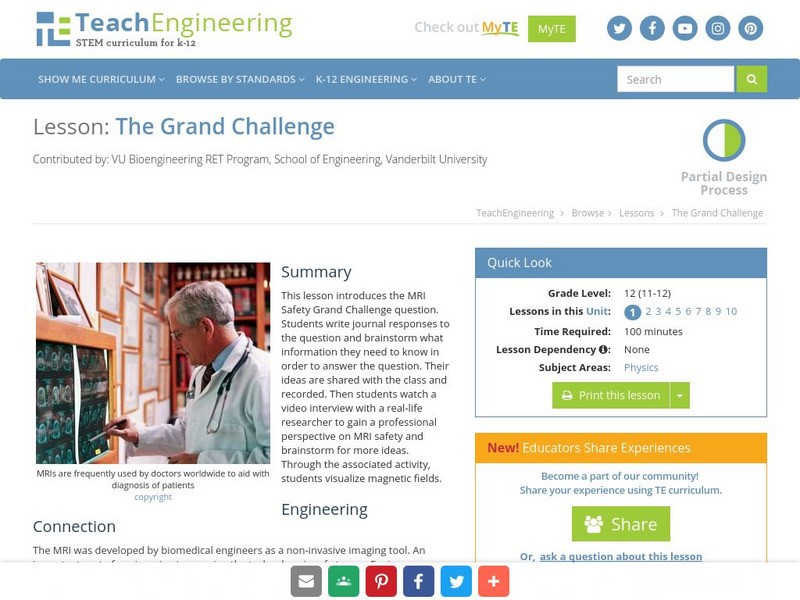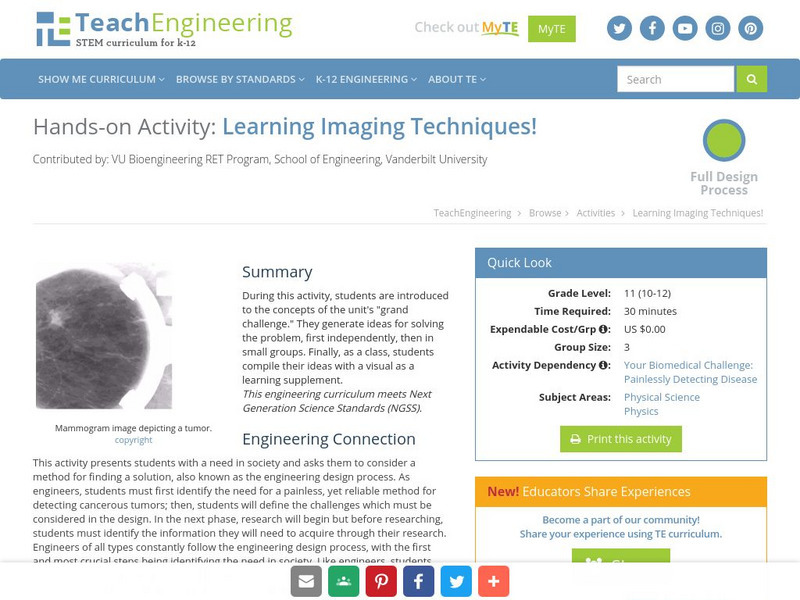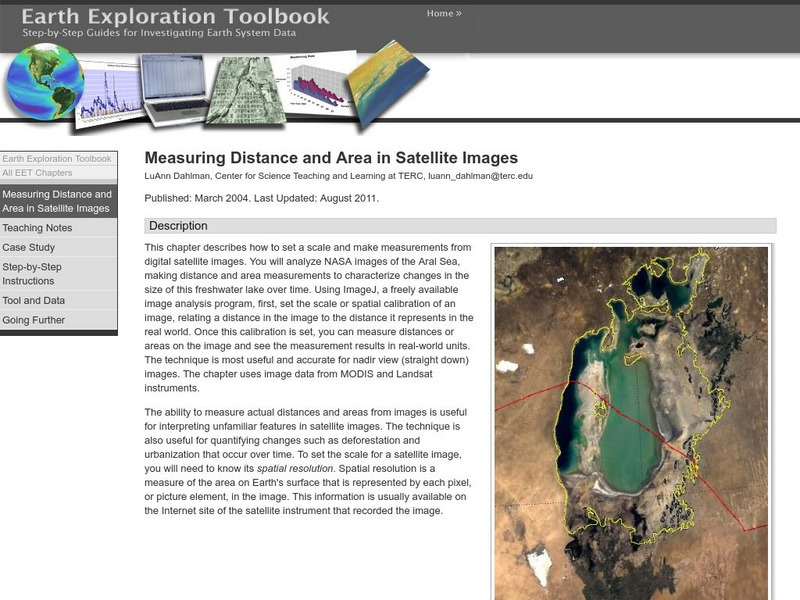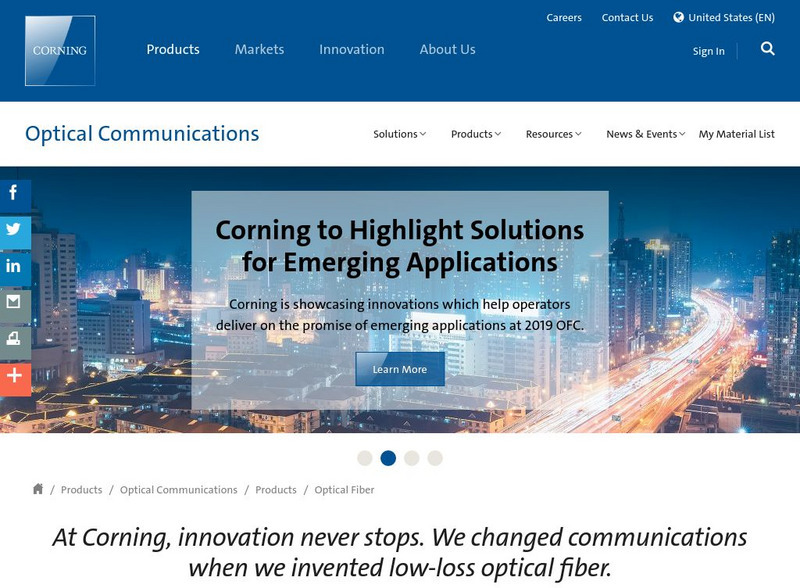Teach Engineering
Thrown for a Loop
Round and round it goes. Class members observe a current carrying loop in a magnetic field and calculate its associated torque. They then apply what they have learned to example problems to solve for the torque and to calculate the...
Curated OER
Detecting Breast Cancer
Students develop a painless means for identifying cancerous tumors. In this imaging lesson students list the information that may be needed to answer the problem.
Curated OER
From the Mouths of Space Scientists: An Introduction to Space and Weather
After researching the Greenland Space Science Symposium, curious thinkers create a PowerPoint or video presentation. They use the information they gathered to construct their presentation.
Curated OER
Imag(in)ing History Across Generations
Students write a one-page letter to their Grand-Students in explanation of the image and why they chose to preserve this image for them.
Lawrence Berkeley National Laboratory
Berkeley Lab: Micro Worlds Project: Advanced Light Source
A discussion of the Advanced Light Source (ALS) facility and its use in material analysis and medicine.
University of Colorado
University of Colorado: Physics 2000: Cat Scans: Projecting Shadows
This page and the three pages which follow discuss how X-ray technology can be used to produce an image of the human body. Discussion is understandable and highly intriguing. Several interactive animations allow the visitor to explore...
The Association of the British Pharmaceutical Industry
Abpi: History of Medicine
A complete, self-guided lesson on the history of medicine and the advancements in medical technology. An interactive, virtual timeline helps students visualize the historical events. There is a self-checking quiz at the end of the lesson.
TeachEngineering
Teach Engineering: Detecting Breast Cancer
This lesson introduces students to their task of developing a painless means of identifying cancerous tumors. Solving the challenge will depend on an understanding of the properties of stress and strain. After being introduced to the...
TeachEngineering
Teach Engineering: The Grand Challenge
This lesson introduces the MRI Safety Grand Challenge question. Students are asked to write journal responses to the question and brainstorm what information they will need to answer the question. The ideas are shared with the class and...
TeachEngineering
Teach Engineering: Thrown for a Loop
In this lesson plan, students begin to focus on the torque associated with a current carrying loop in a magnetic field. Students are prompted with example problems and use diagrams to visualize the vector product. In addition, students...
TeachEngineering
Teach Engineering: Learning Imaging Techniques!
During this activity, students will be introduced to the concepts of the challenge. They will generate ideas for solving the grand challenge first independently, then in small groups. Finally, as a class, students will compile their...
Science Education Resource Center at Carleton College
Serc: Measuring Distance and Area in Satellite Images
Students will select from a series of Satellite images of the Aral Sea from 1973 through 2003 and will measure changes in the area of the lake and distance across the lake over time.
Other
Corning Optical Fibers
Corning serves as a leader in optical fiber technology and this website provides information about the uses of optical fibers in medical imaging, communication, etc., as well as industry news and related resources.
Other
Understanding the Brain: Watching the Brain in Action
Explanation of the use of functional magnetic resonance imaging (fMRI) to view the brain in action.
Energy4Me
Energy4me: Seismic Activity
Find out about the process of seismic imaging which is used in conjunction with hydraulic fracturing.
NASA
Nasa: Mission: Science: Electromagnetic Spectrum: Infrared Waves
Infrared light lies between the visible and microwave portions of the electromagnetic spectrum. Infrared light has a range of wavelengths, just like visible light has wavelengths that range from red light to violet.
Georgia State University
Georgia State University: Hyper Physics: Fiber Optics
This physics department site provides a discussion and explanation of fiber optics and fiber optic imaging.
NASA
Nasa: Electromagnetic Spectrum: Radio Waves
Radio waves have the longest wavelengths in the electromagnetic spectrum. This NASA article discusses AM, FM, TV, cell phone, as well as radio astronomy, which all use this technology.
Other
Nec
Check the level of computing you are interested in, and NEC has the information for you. They have a section for peripherals and imaging, software, and computers. You can also find out general information you need about the company.
NASA
Electromagnetic Spectrum: Ultraviolet Waves
Ultraviolet (UV) light has shorter wavelengths than visible light. Though these waves are invisible to the human eye, some insects can see them. The specific wavelength values are given. Uses and applications of these waves are explained.
University of Colorado
University of Colorado: Physics 2000: X Rays
Here's a really simple demonstration of a fluoroscope. There are links to more information about the uses of X-rays as well.
PBS
Pbs Teachers:pieces of Mind: True or False?
Test your visual recall memory by studying and reproducing from memory drawings of furnished rooms. Explore five mnemonic devices to find the memory aid that works best for you.
PBS
Pbs Teachers: Scientific American: Science and the Brain
Describe the "mush-brain" effect, and test blindfolded subjects for their ability to identify items by smell. Explore the effect of biofeedback to help overcome illnesses, and attempt the mind-over-body techniques of visualizing and...
Other
Medinfo.co.uk: Details of Ultrasound Scanning
An explanation of ultrasound scanning: the procedure, its purpose, and its uses in viewing a fetus, heart valves, and so on.




















